family
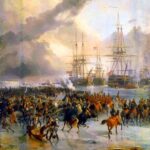
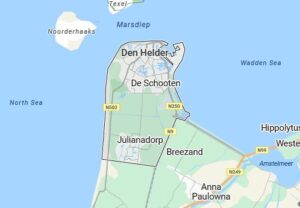 Anytime a country, engaged in a war, can capture a ship belonging to their enemy, they will find themselves strategically in a better position than before, but to capture the entire fleet…now that can mean the difference between winning and losing the war. On January 23, 1795, at Den Helder, North Holland, Netherlands, an extremely rare occurrence took place when a French Revolutionary Hussar cavalry regiment came across a Dutch fleet at anchor in the Nieuwediep, just east of the town of Den Helder. While it was not unusual to come across ships at anchor, what is extremely rare is an interaction between warships and cavalry. One being on land and one on the water, usually prevented any interaction, since the men on horses couldn’t carry guns big enough to reach the ships under normal conditions. The difference in this situation was, of course, that the Dutch fleet was frozen at anchor, not simply sitting at anchor. They had no place they could go. The men on the Dutch fleet knew that they were “sitting ducks” with no recourse, so after some of the Hussars had approached across the frozen Nieuwediep, a negotiation began. It was decided that all 14 Dutch warships would remain at anchor. It was a pretty easy negotiation, because in reality, the Dutch fleet had no other choice. They were now prisoners of war and their capture had happened without violence or even a battle. In an extremely rare even the Dutch fleet was captured by the French Revolutionary Hussars on horseback.
Anytime a country, engaged in a war, can capture a ship belonging to their enemy, they will find themselves strategically in a better position than before, but to capture the entire fleet…now that can mean the difference between winning and losing the war. On January 23, 1795, at Den Helder, North Holland, Netherlands, an extremely rare occurrence took place when a French Revolutionary Hussar cavalry regiment came across a Dutch fleet at anchor in the Nieuwediep, just east of the town of Den Helder. While it was not unusual to come across ships at anchor, what is extremely rare is an interaction between warships and cavalry. One being on land and one on the water, usually prevented any interaction, since the men on horses couldn’t carry guns big enough to reach the ships under normal conditions. The difference in this situation was, of course, that the Dutch fleet was frozen at anchor, not simply sitting at anchor. They had no place they could go. The men on the Dutch fleet knew that they were “sitting ducks” with no recourse, so after some of the Hussars had approached across the frozen Nieuwediep, a negotiation began. It was decided that all 14 Dutch warships would remain at anchor. It was a pretty easy negotiation, because in reality, the Dutch fleet had no other choice. They were now prisoners of war and their capture had happened without violence or even a battle. In an extremely rare even the Dutch fleet was captured by the French Revolutionary Hussars on horseback.
Jean-Charles Pichegru was the leader of the French units…the 8th Hussar Regiment and the Voltigeur company of the 15th Line Infantry Regiment of the French Revolutionary Army, who had been assigned to invade the Dutch Republic. The Dutch fleet was commanded by captain Hermanus Reintjes. This rare event took place during the War of the First Coalition, which was part of the French Revolutionary Wars. The little town of Den Helder is located at the tip of the North Holland peninsula, south of the island of Texel, near the shallow Zuiderzee bay (which means Southern Sea). The Zuiderzee was closed off and partly drained in the 20th century, and what is left of it now forms the freshwater IJsselmeer.
Nevertheless, in the fall of 1794, during the War of the First Coalition of the French Revolutionary Wars, the area was the site of one of the most bizarre captures in history. That day, the Dutch proclaimed the Batavian Republic, effectively ending the war with France and allying itself with France instead. Suddenly, the French were no longer enemies of the Dutch, which seems like a good move in light of the capture. Nevertheless, there were those among the Dutch Navy and the army there who remained loyal to the Stadtholder, and there were fears that Navy ships from Den Helder might sail for England to rejoin William V, Prince of Orange. For that reason, the new Batavian interim Government issued orders to all its fleets at Vlissingen, Hellevoetsluis and at Den Helder, not to fight against the French if they appeared, and to keep the ships at anchor to make sure they could be ready to defend the new Republic against the British.
This event might not have been possible, were it not for the fact that the winter of 1794–1795 was exceptionally cold, causing the Zuiderzee to freeze. Pichegru saw an opportunity and ordered General of Brigade Jan Willem de Winter to lead a squadron of the 8th Hussar Regiment to Den Helder. De Winter had been serving with the French since 1787 and would later command the Dutch fleet in the disastrous Battle of Camperdown. So, while he was successful in one operation, he might not have been the best leader in the long 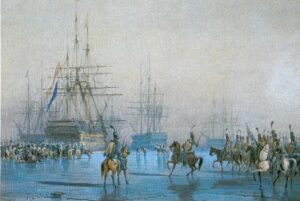
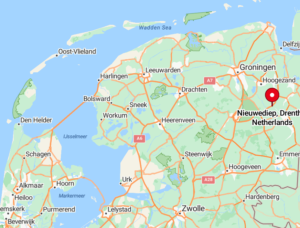 run. Still, the operation was carried out with no casualties. The French simply received the assurance from the Dutch captain that the vessels and their crews would remain at anchor until the political situation in the Dutch Republic would have become clear. The situation was finally settled in May 1795 under the Treaty of The Hague, when the Batavian Republic officially became a French ally. Now, its ships would serve a common cause.
run. Still, the operation was carried out with no casualties. The French simply received the assurance from the Dutch captain that the vessels and their crews would remain at anchor until the political situation in the Dutch Republic would have become clear. The situation was finally settled in May 1795 under the Treaty of The Hague, when the Batavian Republic officially became a French ally. Now, its ships would serve a common cause.
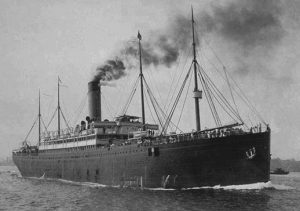 Known as the “Millionaires’ Ship” because of the number of wealthy Americans who traveled by her, RMS Republic was a “palatial liner” and the flagship of White Star Line’s Boston service. She was a steam-powered ocean liner built in 1903 by Harland and Wolff in Belfast, Northern Ireland. The ship was equipped with some of the latest technology of the time, including a new Marconi wireless telegraphy transmitter. All that new equipment would come in handy when disaster struck.
Known as the “Millionaires’ Ship” because of the number of wealthy Americans who traveled by her, RMS Republic was a “palatial liner” and the flagship of White Star Line’s Boston service. She was a steam-powered ocean liner built in 1903 by Harland and Wolff in Belfast, Northern Ireland. The ship was equipped with some of the latest technology of the time, including a new Marconi wireless telegraphy transmitter. All that new equipment would come in handy when disaster struck.
In the early morning of January 23, 1909, while sailing from New York City to Gibraltar and Mediterranean ports with 742 passengers and crew. Captain Inman Sealby was in command, when RMS Republic entered a thick fog off the island of Nantucket, Massachusetts. True to her reputation, RMS Republic was carrying a number of illustrious passengers, such as James Ross Mellon, his wife Rachel Hughey Larimer Mellon, their daughter Sarah of the Mellon banking family and family maid; Mrs Sophie Mansfield Curtis, wife of George Munson Curtis (treasurer of the International Silver Company); Mrs Mary Harriman Severance, wife of Cordenio A Severance; 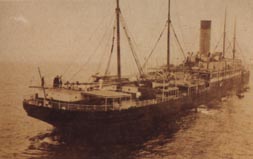 Professor John M Coulter, his wife and children; General Brayton Ives; St. Louis millionaire Samuel Cupples; historian Alice Morse Earle; and Mildred Montague, Countess Pasolini. Also, travelling in first class were Mr Leonard L. McMurray, who, in 1915, would survive the sinking of the Cunard liner Lusitania; and Mrs. Bessie Armstead Davis, daughter-in-law of senator Henry G. Davis of West Virginia with her two children.
Professor John M Coulter, his wife and children; General Brayton Ives; St. Louis millionaire Samuel Cupples; historian Alice Morse Earle; and Mildred Montague, Countess Pasolini. Also, travelling in first class were Mr Leonard L. McMurray, who, in 1915, would survive the sinking of the Cunard liner Lusitania; and Mrs. Bessie Armstead Davis, daughter-in-law of senator Henry G. Davis of West Virginia with her two children.
At 5:30am, disaster struck when RMS Republic collided with the Lloyd Italiano liner SS Florida just off Nantucket, Massachusetts. It took a while, but by about 8:40pm on January 24, 1909, RMS Republic slipped beneath the water and landed on the bottom of the ocean floor at a depth of about 250 feet. While the evacuation process was praised as flawless at the time, a total of six lives were lost, nevertheless. It has been rumored that RMS Republic was also carrying a treasure ranging from $250,000 to $3,000,000 in estimates of the value. Of course, it would likely be worth hundreds of millions of dollars, and maybe even a billion today. The SS Florida survived the collision and was later repaired.
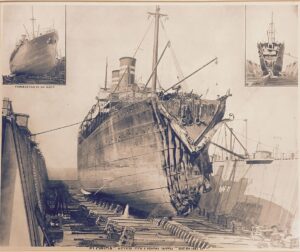
These days, the wreck is owned by father and son Martin and Grant Bayerle, and a television series entitled “Billion Dollar Wreck” is in the process of recovering the contents of the ship. Some of the contents have been recovered, yielding significant amounts of gold and artifacts and brought to the surface by an ROV built specifically for the recovery. The total value of the recovered gold was estimated at $100–150 million. Of course, that is just rumor at this point. The shipwreck itself is 250 feet under water and much of it has deteriorated. It is said that the vaults that contain the alleged treasure appear to be very much intact. Again, time will tell.

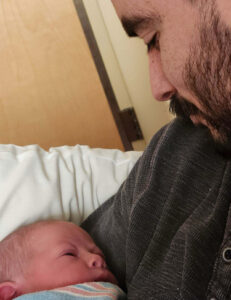 On January 15, 2024, at 8:31am, my niece, Siara Kirk and her husband, Chris were blessed with the birth of their first child together…a beautiful baby boy named Nathaniel Andrew Kirk. Nataniel was delivered by c-section, weighed in at 8 pounds 7 ounces and was 19.75 inches long. He has dark hair, but not very much of it yet, and I could try to guess who he looks like, but I’m not very good at that. If I had to guess, I would say that I rather think maybe he is his daddy’s boy. Nathaniel is a baby that is so, so very wanted. I know you might say that most babies are so wanted, but for Siara, Nathaniel is her “Rainbow Baby” because she lost her first son, Alec Todd Olsen when he was 3 days short of three months old. For Chris, Nathaniel is the fulfillment of a lifelong dream of having a family of his own. When Chris looked at his precious son, he said that it just “feels so natural” to him. Parenthood…oh yes, it feels so perfectly natural, because it is such a
On January 15, 2024, at 8:31am, my niece, Siara Kirk and her husband, Chris were blessed with the birth of their first child together…a beautiful baby boy named Nathaniel Andrew Kirk. Nataniel was delivered by c-section, weighed in at 8 pounds 7 ounces and was 19.75 inches long. He has dark hair, but not very much of it yet, and I could try to guess who he looks like, but I’m not very good at that. If I had to guess, I would say that I rather think maybe he is his daddy’s boy. Nathaniel is a baby that is so, so very wanted. I know you might say that most babies are so wanted, but for Siara, Nathaniel is her “Rainbow Baby” because she lost her first son, Alec Todd Olsen when he was 3 days short of three months old. For Chris, Nathaniel is the fulfillment of a lifelong dream of having a family of his own. When Chris looked at his precious son, he said that it just “feels so natural” to him. Parenthood…oh yes, it feels so perfectly natural, because it is such a 
 wonderful, beautiful, miracle of God!!
wonderful, beautiful, miracle of God!!
When I looked at the pictures of this sweet little family, I could easily see the total love these parents have for their precious little boy. They have both waited so long for this little miracle, and now he is a reality…and they are so blessed. Nathaniel is a good baby, who doesn’t cry very much. I suppose that could change as he gets a little older, but I know that Siara and Chris won’t mind that one bit. Babies get noisy, and there will be far more laughter than tears in the future, and the giggly, laughter 
 moments in the life of a baby are simply the best thing ever. They never get old.
moments in the life of a baby are simply the best thing ever. They never get old.
Nathaniel (aka Nathan or Nate the Great) joins his parents to make them a family. His name was chosen with great care. In Hebrew it means “Gift from Heaven” and little Nathaniel is just that a wonderful gift from Heaven. On that day…January 15, that little gift from Heaven made his appearance, and with that, Siara and Chris stepped across another threshold…the one to parenthood. Their lives have been forever changed. Their home is filled with sunshine, their days filled with smiles, the precious sounds of their baby cooing, giggling, and even crying are the greatest sounds they have ever, or ever will hear. Congratulations Siara and Chris, and we welcome little Nathaniel Andrew Kirk. We love you very much!!
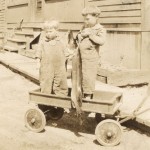
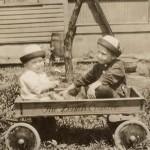 It’s hard for me to believe that my uncle, Bill Spencer has been in Heaven for more than three years already. Uncle Bill chose Christmas Day to go. I think maybe he wanted to spend the holiday with his parents and siblings. He was the last of the original family to go to Heaven, and with Covid stalking the world, he didn’t get to see his children as much either. Since Uncle Bill had Dementia, he probably didn’t realize that he didn’t get to see much of his family, but they knew it, and it made them sad. There were months and months during which they could not go visit him, and sadly it didn’t matter that all these precautions were taken. Uncle Bill still got Covid, and by Christmas Day, he was ready to go home. And so, on Christmas Day 2020, the Spencer brothers got back together again.
It’s hard for me to believe that my uncle, Bill Spencer has been in Heaven for more than three years already. Uncle Bill chose Christmas Day to go. I think maybe he wanted to spend the holiday with his parents and siblings. He was the last of the original family to go to Heaven, and with Covid stalking the world, he didn’t get to see his children as much either. Since Uncle Bill had Dementia, he probably didn’t realize that he didn’t get to see much of his family, but they knew it, and it made them sad. There were months and months during which they could not go visit him, and sadly it didn’t matter that all these precautions were taken. Uncle Bill still got Covid, and by Christmas Day, he was ready to go home. And so, on Christmas Day 2020, the Spencer brothers got back together again.
My dad, Allen Spencer was two years younger than his brother, Bill, but they were the very best of friends. When they were together, you didn’t have to ask them to talk about their childhood, all you have to do was sit back and listen, because the stories were the talk of the day. They had so many great adventures. They would go fishing, swimming, and boating with friends. They also loved getting into mischief, and dynamite was one of 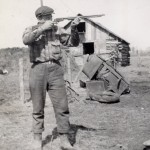
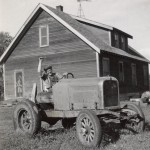 their favorite mischief makers. They normally used dynamite to remove tree stumps, but they weren’t above the Independence Day “fireworks” display or the “gate post” experiment. They were very industrious boys, and in those days, before things like video games, television (while it did exist, was not common in every household), and telephones (they were first in homes in 1856, but only 35% of homes in the 1920s had one), kids actually played outside, and used their imaginations. These brothers had the best time. They rode their bicycles for miles and miles. They hopped the trains…no, not like illegally. These boys had a pass, because their dad worked on the trains, but they never simply boarded a train…they hopped the train, even though they were scolded for it, they hopped the trains anyway. Danger be hanged!! Oh, the adventures they had.
their favorite mischief makers. They normally used dynamite to remove tree stumps, but they weren’t above the Independence Day “fireworks” display or the “gate post” experiment. They were very industrious boys, and in those days, before things like video games, television (while it did exist, was not common in every household), and telephones (they were first in homes in 1856, but only 35% of homes in the 1920s had one), kids actually played outside, and used their imaginations. These brothers had the best time. They rode their bicycles for miles and miles. They hopped the trains…no, not like illegally. These boys had a pass, because their dad worked on the trains, but they never simply boarded a train…they hopped the train, even though they were scolded for it, they hopped the trains anyway. Danger be hanged!! Oh, the adventures they had.
When the United States entered World War II, the brothers were all set to go into the Army Air Force together, but Uncle Bill had a hernia and flat feet, so they wouldn’t take him. My dad went in alone, and his big brother, who had always been there to take care of him, was…well, a little frantic about it. He didn’t want my dad to go 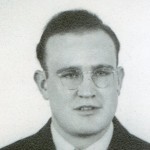
 without him. He worried about his little brother. Sending any family member into the military in times of war, is something any family would worry about, and Uncle Bill was no exception. So, while his brother fought in the war, Uncle Bill worked on the planes here at home. Uncle Bill was a welder, and his skills were very important in the building of the planes that would fight and eventually win World War II. His was a very important job, and I am very proud of the part he played in the victory. Today would have been Uncle Bill’s 102nd birthday. Happy birthday in Heaven, Uncle Bill. We love and miss you very much.
without him. He worried about his little brother. Sending any family member into the military in times of war, is something any family would worry about, and Uncle Bill was no exception. So, while his brother fought in the war, Uncle Bill worked on the planes here at home. Uncle Bill was a welder, and his skills were very important in the building of the planes that would fight and eventually win World War II. His was a very important job, and I am very proud of the part he played in the victory. Today would have been Uncle Bill’s 102nd birthday. Happy birthday in Heaven, Uncle Bill. We love and miss you very much.

 I don’t suppose many of the young people of today would even remember the Iran Hostage Crisis, but I remember. It all started on November 6, 1979, when a group of militarized Iranian college students belonging to the Muslim Student Followers of the Imam’s Line, who supported the Iranian Revolution, took over the US Embassy in Tehran. Inside the embassy were American diplomats and citizens, and their lives were about to be forever changed. The Western media called the crisis an “entanglement of vengeance and mutual incomprehension.” US President Jimmy Carter called the hostage-taking an act of “blackmail” and the hostages “victims of terrorism and anarchy.” Of course, the Iranians view it in a much different way, calling it an act against the US and its influence in Iran, including its perceived attempts to undermine the Iranian Revolution and its long-standing support of the Shah of Iran, Mohammad Reza Pahlavi, who was overthrown in 1979. The Shah left the US in December 1979 and was ultimately granted asylum in Egypt, where he died of cancer at age 60 on July 27, 1980.
I don’t suppose many of the young people of today would even remember the Iran Hostage Crisis, but I remember. It all started on November 6, 1979, when a group of militarized Iranian college students belonging to the Muslim Student Followers of the Imam’s Line, who supported the Iranian Revolution, took over the US Embassy in Tehran. Inside the embassy were American diplomats and citizens, and their lives were about to be forever changed. The Western media called the crisis an “entanglement of vengeance and mutual incomprehension.” US President Jimmy Carter called the hostage-taking an act of “blackmail” and the hostages “victims of terrorism and anarchy.” Of course, the Iranians view it in a much different way, calling it an act against the US and its influence in Iran, including its perceived attempts to undermine the Iranian Revolution and its long-standing support of the Shah of Iran, Mohammad Reza Pahlavi, who was overthrown in 1979. The Shah left the US in December 1979 and was ultimately granted asylum in Egypt, where he died of cancer at age 60 on July 27, 1980.
The attack did not go as it was originally planned. The students had planned a “symbolic” occupation, aimed at getting their cause before the media. The, they planned to release statements to the press and leave when government security forces came to restore order. This was documented by the placards that said, “Don’t be afraid. We just want to sit in.” Then, the embassy guards brandished firearms, so the protesters retreated. As he left, one of the students told the Americans, “We don’t mean any harm.” When it became clear that the guards would not use deadly force and that a large, angry crowd had gathered outside the compound to cheer the occupiers and jeer the hostages, the plan drastically changed. Then, according to one embassy staff member, buses full of demonstrators began to appear outside the embassy. A short time later, the Muslim Student Followers of the Imam’s Line broke through the gates. And so began the hostage crisis.
On January 27, 1980, six American diplomats who had managed to evade capture when all this began, were  rescued by a joint CIA–Canadian effort. The crisis reached a climax in early 1980 after diplomatic negotiations failed to win the release of the hostages. President Jimmy Carter ordered the US military to attempt a rescue mission, which was called Operation Eagle Claw…using warships that included USS Nimitz and USS Coral Sea, which were patrolling the waters near Iran. That attempted rescue failed on April 24, 1980, and resulted in the death of one Iranian civilian and the accidental deaths of eight American servicemen after one of the helicopters crashed into a transport aircraft. The failure resulted in the resignation of US Secretary of State Cyrus Vance. Then, Iraq invaded Iran, beginning the Iran–Iraq War on September 1980. At that point, the Iranian government reached out to the US government, with Algeria acting as a mediator.
rescued by a joint CIA–Canadian effort. The crisis reached a climax in early 1980 after diplomatic negotiations failed to win the release of the hostages. President Jimmy Carter ordered the US military to attempt a rescue mission, which was called Operation Eagle Claw…using warships that included USS Nimitz and USS Coral Sea, which were patrolling the waters near Iran. That attempted rescue failed on April 24, 1980, and resulted in the death of one Iranian civilian and the accidental deaths of eight American servicemen after one of the helicopters crashed into a transport aircraft. The failure resulted in the resignation of US Secretary of State Cyrus Vance. Then, Iraq invaded Iran, beginning the Iran–Iraq War on September 1980. At that point, the Iranian government reached out to the US government, with Algeria acting as a mediator.
The hostage-takers, declaring their solidarity with other “oppressed minorities” and declaring their respect for “the special place of women in Islam,” released one woman and two African Americans on November 19, 1979. Before the release, these hostages were required by their captors to hold a press conference in which Kathy Gross and William Quarles praised the revolution’s aims and goals. Four more women and six African Americans were released the following day. According to the then United States Ambassador to Lebanon, John Gunther Dean, the 13 hostages were released with the assistance of the Palestine Liberation Organization, after Yassir Arafat and Abu Jihad personally traveled to Tehran to secure a concession. The only African American hostage that was not released that month was Charles A Jones Jr. One more hostage, a white man named Richard Queen, was released in July 1980 after he became seriously ill. He was later diagnosed with multiple sclerosis.
The remaining 52 hostages were held until January 20, 1981, a full 444 days of captivity. The agreed upon release came with an agreement, on January 19, 1981, in which Iran released all of the hostages and the US freed 8 billion US dollars of Iranian State assets from American banks. Then on January 20, 1981, US president-elect Ronald Reagan takes the oath of office. Just 20 minutes after Reagan’s oath, Iran released all 52 hostages, who were then flown to West Germany, by way of Algeria where former US president Jimmy Carter takes them back to the United States. Some people saw the release in a bit of a conspiracy light, 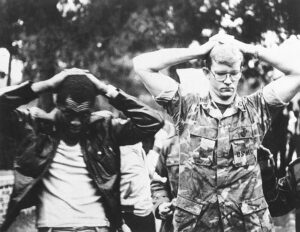
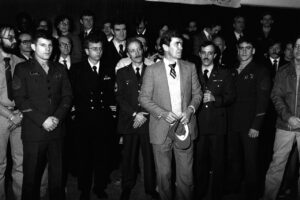 because of its closeness to the swearing in of President Reagan. I suppose we will never know for sure. Ten days after the release of the hostages a motorcycle parade takes place in New York City’s Broadway. Whatever the case may be, and no matter what kind of celebration was held in their honor, the lives of those hostages were forever changed. You can’t lose 444 days of your life and stay the same. Too much was forever missing. Things they could never get back.
because of its closeness to the swearing in of President Reagan. I suppose we will never know for sure. Ten days after the release of the hostages a motorcycle parade takes place in New York City’s Broadway. Whatever the case may be, and no matter what kind of celebration was held in their honor, the lives of those hostages were forever changed. You can’t lose 444 days of your life and stay the same. Too much was forever missing. Things they could never get back.
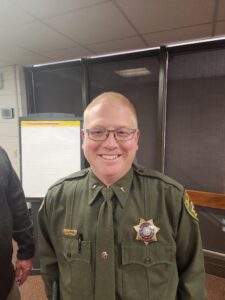
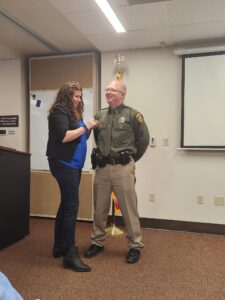 My nephew, Jason Sawdon finished last year with a very nice promotion. Jason was a sergeant with the Wyoming Highway Patrol. His position was that of Sergeant of Equipment and Technology. In that position, Jason trained men on the equipment and technology. The position took Jason and his family from Casper to Cheyenne, but it was a good move, because it also took Jason off the street and into a Monday through Friday, day job. That meant he was home at night, and that was best for him and his girls, wife Jessi and daughter, Adelaide. That move took place on June 5, 2021. Now, just two and a half years later, Jason is “movin’ on up” again, and we are so pleased and so happy for him.
My nephew, Jason Sawdon finished last year with a very nice promotion. Jason was a sergeant with the Wyoming Highway Patrol. His position was that of Sergeant of Equipment and Technology. In that position, Jason trained men on the equipment and technology. The position took Jason and his family from Casper to Cheyenne, but it was a good move, because it also took Jason off the street and into a Monday through Friday, day job. That meant he was home at night, and that was best for him and his girls, wife Jessi and daughter, Adelaide. That move took place on June 5, 2021. Now, just two and a half years later, Jason is “movin’ on up” again, and we are so pleased and so happy for him.
On December 16, 2023, Jason was again promoted…this time  to Lieutenant. That promotion also promoted him to Support Services Supervisor of Equipment and Technology. Basically, the job is similar, but now he supervises the men doing the training. Jason is such a great member of the highway patrol. It doesn’t matter which position he is in, because he always excelled. No wonder the highway patrol wanted to take advantage of that talent by promoting him to positions where he could use his skills to improve the patrol base of skilled men. To top it off, Jason has such a great personality, that people simply like him. Whether it is his bosses, his coworkers, and even the people he dealt with on patrol. Jason is respected and very well liked.
to Lieutenant. That promotion also promoted him to Support Services Supervisor of Equipment and Technology. Basically, the job is similar, but now he supervises the men doing the training. Jason is such a great member of the highway patrol. It doesn’t matter which position he is in, because he always excelled. No wonder the highway patrol wanted to take advantage of that talent by promoting him to positions where he could use his skills to improve the patrol base of skilled men. To top it off, Jason has such a great personality, that people simply like him. Whether it is his bosses, his coworkers, and even the people he dealt with on patrol. Jason is respected and very well liked.
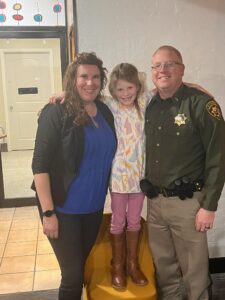
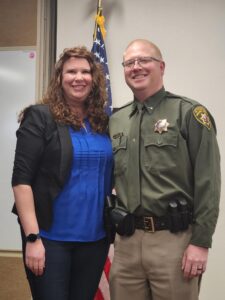
Today, Jason had his promotion ceremony, and it was a great ceremony. His wife Jessi had the privilege of pinning his lieutenant’s bars on, and many of the family members attended. Jason’s coworkers and family had many nice things to say about him, listing his accomplishments…that he was Trooper of the year in 2015 and his Meritorious Service Award. He was skilled in Crash Reconstruction and worked the 1-80 pileup crash a few years ago to reconstruct it. Then there was a wonderful reception at Paris West restaurant. It was a beautiful day…one that Jason has worked hard for. It wouldn’t surprise me to see more promotion days in Jason’s future, because he is so good at his job. Congratulations Lieutenant Jason Sawdon on your promotion!! We are so proud of you!!
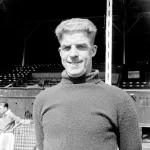 We all know that travel plans can be hampered due to weather conditions, and for drivers, one of the worst weather situations for driving is fog. Of course, weather can affect more than just travel plans. Over the years, we have seen many sporting events called for weather. Everything from snow, to rain, and even fog, although a game called for fog is probably less likely to happen than rain or snow. Still, it isn’t outside the realm of possibilities. It wouldn’t make good sense to try to catch a baseball in the fog. Someone is likely to get hurt. So, games would need to be called for fog, but maybe because a lot of games are played in the afternoon, the fog has had time to burn off.
We all know that travel plans can be hampered due to weather conditions, and for drivers, one of the worst weather situations for driving is fog. Of course, weather can affect more than just travel plans. Over the years, we have seen many sporting events called for weather. Everything from snow, to rain, and even fog, although a game called for fog is probably less likely to happen than rain or snow. Still, it isn’t outside the realm of possibilities. It wouldn’t make good sense to try to catch a baseball in the fog. Someone is likely to get hurt. So, games would need to be called for fog, but maybe because a lot of games are played in the afternoon, the fog has had time to burn off.
In one strange occurrence, during a soccer match between Charlton Athletic and Chelsea in 1937, in the United Kingdom, goalkeeper for the UK’s Charlton Athletic, 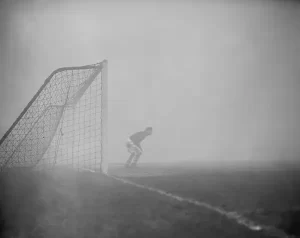 Sam Bartram once stood alone on the field for 15 minutes because he didn’t realize the game had been called off due to heavy fog. Now, if you ask me, that’s ludicrous. Why would he just stand there at the goal for 15 minutes after the game was called!!
Sam Bartram once stood alone on the field for 15 minutes because he didn’t realize the game had been called off due to heavy fog. Now, if you ask me, that’s ludicrous. Why would he just stand there at the goal for 15 minutes after the game was called!!
During the match, a thick fog rolled over the field. It was a very thick fog. The referees decided that this fog was so think that the players were not safe running all over the field, much less dodging a ball too. So, the match was called off, but somehow, Bertram didn’t hear the call, or the whistle or whatever was used to call the game, so he stood there at is post…the goal at the end of the field…alone. Somehow, no one told Bertram that the game had been called, probably because the couldn’t see that he was still out there. So, 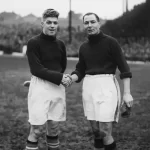 Bertram waited for 15 minutes for the ball to come his way…a full 15 minutes. That’s crazy. How could he have had no idea? Well, somehow Bertram just thought his team was on a “crazy offensive run, pinning down the Chelsea defense, but somehow failing to actually score a goal.” So, there he stood, until finally, a police officer went on the field, and with a look of shock, said something like, “What the heck are you doing? The game’s over, mate.” Well, a rather embarrassed Bartram shuffled off to the locker room, where he was met with unrestrained laughter by his rather rude teammates. They all knew that he was still out there, and no one had made the move to go get him. Well, Bertram got over it, because they were his teammates, and even if it was misguided, it was just a joke after all. I’m sure that after that, he stayed much more alert in the fog that tends to plague the United Kingdom.
Bertram waited for 15 minutes for the ball to come his way…a full 15 minutes. That’s crazy. How could he have had no idea? Well, somehow Bertram just thought his team was on a “crazy offensive run, pinning down the Chelsea defense, but somehow failing to actually score a goal.” So, there he stood, until finally, a police officer went on the field, and with a look of shock, said something like, “What the heck are you doing? The game’s over, mate.” Well, a rather embarrassed Bartram shuffled off to the locker room, where he was met with unrestrained laughter by his rather rude teammates. They all knew that he was still out there, and no one had made the move to go get him. Well, Bertram got over it, because they were his teammates, and even if it was misguided, it was just a joke after all. I’m sure that after that, he stayed much more alert in the fog that tends to plague the United Kingdom.

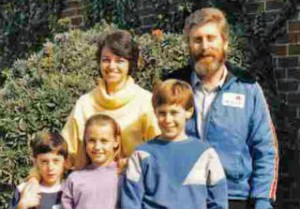 Any illness that takes a life is a tragedy, but sometimes an illness doesn’t take the life, exactly, it just stops everything about that life…in its tracks. In January of 1988 at age 12, Martin Pistorius of South Africa came down with a strange illness. his illness was so unusual, that his doctors weren’t even sure what it was. Nevertheless, they did speculate that it might be Cryptococcal Meningitis. Cryptococcosis is a potentially fatal fungal infection of mainly the lungs, where it presents as a type of pneumonia; and also, the brain, where it appears as a meningitis. The symptoms seem common enough…a cough, difficulty breathing, chest pain, and fever are seen when the lungs are infected. When the brain is infected, symptoms include headache, fever, neck pain, nausea and vomiting, light sensitivity, and confusion or changes in behavior. It can also affect other parts of the body including skin, where it may appear as several fluid-filled nodules with dead tissue.
Any illness that takes a life is a tragedy, but sometimes an illness doesn’t take the life, exactly, it just stops everything about that life…in its tracks. In January of 1988 at age 12, Martin Pistorius of South Africa came down with a strange illness. his illness was so unusual, that his doctors weren’t even sure what it was. Nevertheless, they did speculate that it might be Cryptococcal Meningitis. Cryptococcosis is a potentially fatal fungal infection of mainly the lungs, where it presents as a type of pneumonia; and also, the brain, where it appears as a meningitis. The symptoms seem common enough…a cough, difficulty breathing, chest pain, and fever are seen when the lungs are infected. When the brain is infected, symptoms include headache, fever, neck pain, nausea and vomiting, light sensitivity, and confusion or changes in behavior. It can also affect other parts of the body including skin, where it may appear as several fluid-filled nodules with dead tissue.
As the disease progressed, Pistorius got progressively worse. At first, he lost the ability to move by himself, then his ability to make eye contact, and finally his ability to speak. His parents were told their son was essentially in a vegetative state, basically they were told he was almost brain dead, that he wasn’t “really there” and would die soon. It was the most devastating news a parent could hear, but Pistorius didn’t die. He just stayed in a vegetative state for the next 12 years. His parents couldn’t give up on their son, and so, they took care of him…bathing, dressing, and feeding him. They days turned into years…years of grieving, sadness, weariness, and a sense of having made a mistake, for not “letting him go” sooner. The weariness got so bad that one day, not knowing her son could hear her, Joan Pistorius told him, “I hope you die.” It was a harsh thing to say, but she thought he was brain dead, and she was simply exhausted.
As Joan Pistorius would later find out, to her horror I’m sure, her son heard and understood every word. Somewhere between the ages of 14 and 16, Pistorius had begun to wake up…slowly. At first, it may have been barely noticeable, but at some point, it got to where Pistorius later recalled, “I was aware of everything, just like any normal person.” He could hear, and very much understand and process what he heard, but he couldn’t say or do anything about what he heard or let anyone know that he had heard. The condition Pistorius had, is known as “locked-in syndrome” and can be caused by a stroke, traumatic brain injury, infection, or drug overdose. There is no known cure. I’m sure the situation was even more frustrating for Pistorius, than it was for his mom. Although Pistorius could see, hear, and understand everything, he couldn’t move his body. “Everyone was so used to me not being there that they didn’t notice when I began to be present again,” he later recalled. “The stark reality hit me that I was going to spend the rest of my life like that – totally alone.”
Pistorius made a conscious choice to disengage from his thoughts as his way of coping. Because of his condition, Pistorius spent a lot of time at a care center while his mother worked. He hated the children’s TV show Barney, and that was on constantly there. That show led him to start reengaging with his thoughts in an attempt to take some control of his life. As his thought life improved, so did his body. Then, one glorious day, a relief worker at his daycare center noticed his slight movements and realized Pistorius could communicate. She immediately told his parents, telling them to get another evaluation. Finally, they knew he was conscious. His 
 recovery wasn’t instantaneous, of course, but by age 26, he could use a computer to communicate. Pistorius later enrolled in college, majoring in computer science and started a company online. It was a long road, but he has come full circle, by 2011 when he published his memoir, “Ghost Boy.” Pistorius met his wife Joanna, who is from England in 2008 through his sister Kim, who had moved to there. After meeting Joanna, he moved to England too, and they were married in 2009. By that time, while still using a wheelchair, he was racing in it. Their son, Sebastian Albert Pistorius, was born a few months later.
recovery wasn’t instantaneous, of course, but by age 26, he could use a computer to communicate. Pistorius later enrolled in college, majoring in computer science and started a company online. It was a long road, but he has come full circle, by 2011 when he published his memoir, “Ghost Boy.” Pistorius met his wife Joanna, who is from England in 2008 through his sister Kim, who had moved to there. After meeting Joanna, he moved to England too, and they were married in 2009. By that time, while still using a wheelchair, he was racing in it. Their son, Sebastian Albert Pistorius, was born a few months later.
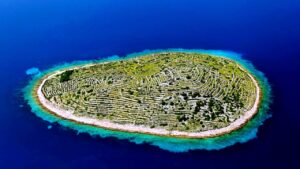
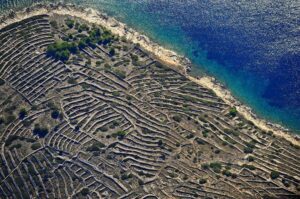 Baljenac (also known as Bavljenac)…a tiny island in the Adriatic Sea, just off the coast of Croatia, seems to be showing up all over the internet these days. When you first see it, you will be…rather shocked by its appearance, because well, it really looks like a giant fingerprint. My first thought was, “Is that natural, or man-made?” Well, of course, the structures are man-made, but their original intent was not to create a giant fingerprint. These dry-stone walls that make up the web that covers the island, have been there for centuries, and their purpose is very different than how they make the island look from the air.
Baljenac (also known as Bavljenac)…a tiny island in the Adriatic Sea, just off the coast of Croatia, seems to be showing up all over the internet these days. When you first see it, you will be…rather shocked by its appearance, because well, it really looks like a giant fingerprint. My first thought was, “Is that natural, or man-made?” Well, of course, the structures are man-made, but their original intent was not to create a giant fingerprint. These dry-stone walls that make up the web that covers the island, have been there for centuries, and their purpose is very different than how they make the island look from the air.
The island is located in the Sibenik archipelago on the Dalmatian coast. The island is quite small…just .75 square miles, and it is completely covered by the web of dry-stone walls. The island’s oval shape along with the web of walls makes it look amazingly like a fingerprint. The long lines of low walls, combined with the oval shape bring about the amazing resemblance. Apparently, these dry-stone walls are not that uncommon in west European nations such as Ireland, England and Scotland, much of Croatia’s countryside. The dry-stone walls hug many of these island nations. Originally, they were used for centuries, to mark boundaries between adjacent agricultural lands. That might make sense, but the walls on Fingerprint Island don’t seem to allow for a very big garden, much less be a separation of agricultural lands. Aside from defining agricultural boundaries, the walls also keep out strong winds known as “Bura” that would make cultivation impossible in exposed locations along the coastline. The walls, however strange and however strange they make the landscape look, served a great purpose, especially since they withstood the test of time.
The walls are unusual because they were built without mortar to hold the stones together. Instead, builders carefully select stones and stack them snug together like puzzle pieces. That seems like a recipe for the collapse of the walls, and yet they have stood in place for centuries. They did have large amounts of rock to work with, because much of Croatia’ coastline is characterized by karst topography…meaning it’s rocky. If 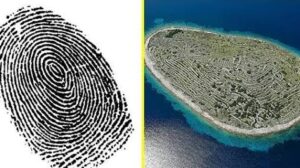 you’re going to grow much on rocky terrain, you have to remove the rocks. So, the farmers painstakingly picked rocks out of the soil by hand and then used the same stones to construct walls around geometric plots. The work, planned to create boundaries, created grids in some cases…and the grids stretched for miles. That seems odd in itself, but in the case of Baljenac (Fingerprint Island), an island just .31 miles long, the walls stretch for 14.29 miles. Because of the length of time the grid has been there, the Croatian government has been pushing the UNESCO to include the island and its dry-stone walls in their World Heritage Sites list.
you’re going to grow much on rocky terrain, you have to remove the rocks. So, the farmers painstakingly picked rocks out of the soil by hand and then used the same stones to construct walls around geometric plots. The work, planned to create boundaries, created grids in some cases…and the grids stretched for miles. That seems odd in itself, but in the case of Baljenac (Fingerprint Island), an island just .31 miles long, the walls stretch for 14.29 miles. Because of the length of time the grid has been there, the Croatian government has been pushing the UNESCO to include the island and its dry-stone walls in their World Heritage Sites list.
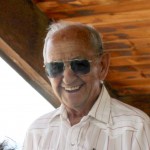
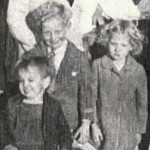 My mom’s brothers, Larry and Wayne Byer were born on either side of her. That made her the middle sister of the family. It also made her part of a threesome. Those three kids were always into so kind of mischief. I can’t say which one of them was the biggest instigator, but if I were to venture a guess, I would say that it would be Uncle Wayne. Even as an adult, Uncle Wayne always had a knack for the “humorous” or mischief as most people call it. As a little boy, that likely got him in trouble with his parents, my Grandma and Grandpa Byer, older siblings, teachers, and other adults. Still, Uncle Wayne’s sense of humor was well known, and much enjoyed by all the kids who knew him then…and those who know him now…as well as, the adults (like me) who used to be one of those kids who loved and enjoyed Uncle Wayne’s sense of humor.
My mom’s brothers, Larry and Wayne Byer were born on either side of her. That made her the middle sister of the family. It also made her part of a threesome. Those three kids were always into so kind of mischief. I can’t say which one of them was the biggest instigator, but if I were to venture a guess, I would say that it would be Uncle Wayne. Even as an adult, Uncle Wayne always had a knack for the “humorous” or mischief as most people call it. As a little boy, that likely got him in trouble with his parents, my Grandma and Grandpa Byer, older siblings, teachers, and other adults. Still, Uncle Wayne’s sense of humor was well known, and much enjoyed by all the kids who knew him then…and those who know him now…as well as, the adults (like me) who used to be one of those kids who loved and enjoyed Uncle Wayne’s sense of humor.
Uncle Wayne has long been a big name in this town…maybe not as one of the wealthiest, or as a top political person, or even as an important schoolteacher, but he was well known and much respected in the school system, nevertheless. The kids all loved him, and so did the teachers, principals, and staff. Uncle Wayne worked hard, and that hard work paid off. People loved him and he loved people. I think his love of people was a big part of his charm. My sisters and I benefitted some because of Uncle Wayne too. Now I don’t mean that we got anything improper, but the staff in the cafeteria always treated us well, as did teachers and office staff. They knew who we were, because we were Uncle Wayne’s nieces.
As boys, Uncle Larry and Uncle Wayne went hunting with their dad to help make ends meet. They grew up in 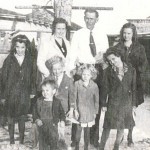
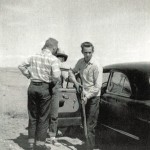 the Great Depression years. Times were tight and everybody needed to help out, and the Byer kids were always willing to help. The kids helped with cooking, cleaning, hunting, fishing, and even financially. The kids didn’t feel cheated either. Their parents were loved and respected, and the kids grew up watching their parents’ giving nature. The older kids helped with the younger kids, and they were just one big happy family, with two parents and nine kids. Their home was filled with love. Today is Uncle Wayne’s 86th birthday. Happy birthday Uncle Wayne!! Have a great day!! We love you!!
the Great Depression years. Times were tight and everybody needed to help out, and the Byer kids were always willing to help. The kids helped with cooking, cleaning, hunting, fishing, and even financially. The kids didn’t feel cheated either. Their parents were loved and respected, and the kids grew up watching their parents’ giving nature. The older kids helped with the younger kids, and they were just one big happy family, with two parents and nine kids. Their home was filled with love. Today is Uncle Wayne’s 86th birthday. Happy birthday Uncle Wayne!! Have a great day!! We love you!!

